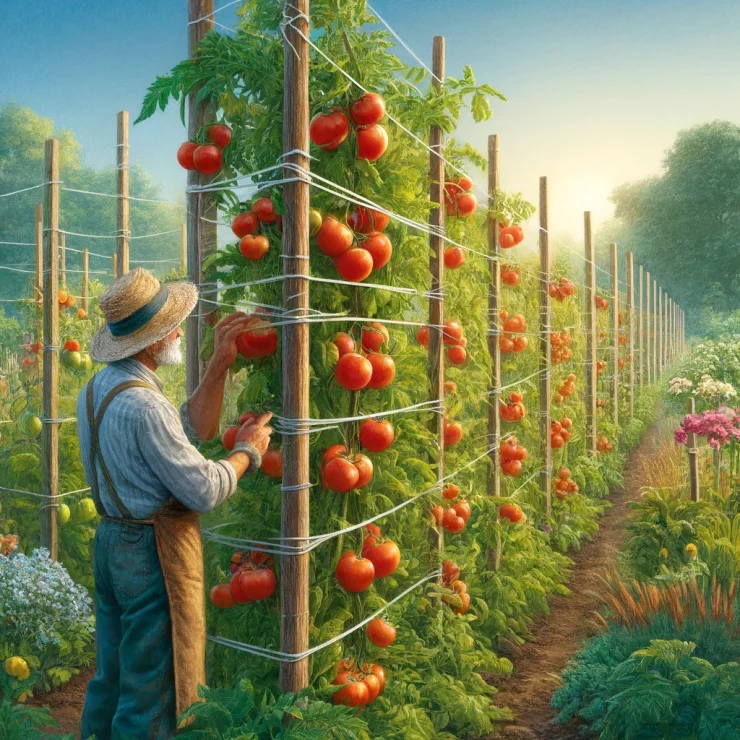Tomatoes are a staple in many gardens, beloved for their versatility in cooking and their vibrant colors. However, growing them can sometimes be a challenge, especially if space is limited. Enter the vertical tomato trellis – a simple yet highly effective solution that not only maximizes space but also promotes healthier plants and bigger harvests.
Why Go Vertical?
Traditional tomato growing methods involve letting the plants sprawl across the ground, which can lead to several issues. Firstly, it takes up a significant amount of space, making it impractical for those with small gardens or limited outdoor areas. Secondly, when tomatoes come into contact with the soil, they are more susceptible to pests, diseases, and rot. Lastly, sprawling plants can be difficult to manage and harvest, often resulting in tangled foliage and damaged fruits.
Vertical gardening offers a solution to these problems by utilizing upward space efficiently. By training tomatoes to grow vertically, gardeners can make the most of their available space, allowing for higher plant density and increased yields. Additionally, keeping the plants off the ground reduces the risk of diseases and pests, leading to healthier plants and better-quality fruits.
Building Your Vertical Tomato Trellis
Building a vertical tomato trellis is a straightforward process that requires minimal materials and expertise. Here’s how to do it:
Materials Needed:
Wooden stakes or posts
Galvanized wire or twine
Tomato clips or soft ties
Steps:
Choose Your Location: Select a sunny spot in your garden or on your patio where your tomato plants will receive at least 6-8 hours of sunlight per day.
Install Your Support Structure: Drive wooden stakes or posts into the ground at regular intervals along the planting area. Make sure they are sturdy enough to support the weight of mature tomato plants.
Attach Wire or Twine: Run galvanized wire or twine horizontally between the stakes, leaving enough space between each line to accommodate the height of your tomato plants.
Plant Your Tomatoes: Plant your tomato seedlings or transplants at the base of each stake, spacing them according to the variety’s recommended spacing guidelines.
Train Your Plants: As your tomato plants grow, gently guide them upward along the trellis using tomato clips or soft ties. Encourage the main stem to grow vertically by pruning away any side shoots or suckers that emerge in the leaf axils.
Regular Maintenance: Throughout the growing season, continue to train your tomato plants to grow vertically and provide support as needed. Water and fertilize regularly to promote healthy growth and fruit production.
Benefits of Vertical Tomato Trellising
Maximized Space: Vertical trellising allows you to grow more tomatoes in a smaller area, making it ideal for gardens with limited space or urban environments.
Improved Air Circulation: By keeping plants off the ground, vertical trellises promote better air circulation around the foliage, reducing the risk of fungal diseases such as blight.
Easier Harvesting: Harvesting tomatoes from a vertical trellis is much easier and less labor-intensive than picking them from sprawling plants on the ground. Fruits are more accessible and less likely to be damaged during harvesting.
Higher Yields: Vertical trellising encourages plants to focus their energy on producing fruits rather than sprawling foliage, resulting in larger harvests of ripe, juicy tomatoes.
Building a vertical tomato trellis is a simple yet effective way to maximize your garden’s productivity and enjoy a bountiful harvest of fresh, homegrown tomatoes. Whether you have a sprawling backyard or a compact balcony, vertical trellising offers a space-saving solution that benefits both plants and gardeners alike. So why wait? Start building your vertical tomato trellis today and reap the rewards of a fruitful harvest tomorrow!






Add comment